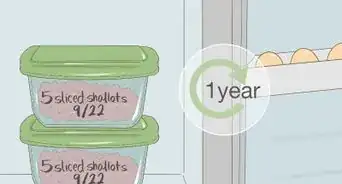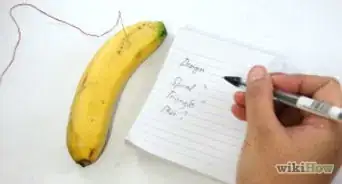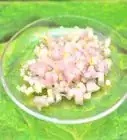This article was co-authored by wikiHow Staff. Our trained team of editors and researchers validate articles for accuracy and comprehensiveness. wikiHow's Content Management Team carefully monitors the work from our editorial staff to ensure that each article is backed by trusted research and meets our high quality standards.
There are 10 references cited in this article, which can be found at the bottom of the page.
This article has been viewed 22,177 times.
Learn more...
Shallots are small onions that have a mild, sweet taste and make a great substitute in recipes calling for their red or yellow cousins. Like any other onion, though, you will have to peel off the shallots’ clingy skin before they can be eaten, which can be a tedious process. You can do this quickly and safely by either removing the skin with a knife or by first loosening the skin in boiling water.
Steps
Peeling Shallots with a Knife
-
1Choose a sharpened knife. Because shallots are fairly small, a paring knife is likely the best option. Paring knives have smaller blades that allow you to make nimble and precise cuts when working with fruits or vegetables.[1]
- You are less likely to injure yourself while working with a sharpened blade as opposed to a dull one because it’s easier to make a cut without slipping when the blade is sharp.[2]
-
2Separate the shallot into individual cloves. Shallots grow like regular onions, but are also in the same family as garlic, meaning that multiple cloves often grow together in one bulb.[3] You can pull the cloves apart with your hands or use the paring knife to slice between where the cloves are connected.Advertisement
-
3Remove the stem end of the shallot clove with the knife. The stem is the narrowest end of the vegetable where the stalk and leaves once were. You should only need to chop off a few centimeters to an inch in order to remove the stem, leaving the most bulbous part of the clove intact.[4]
-
4Chop off the root end of the shallot. The roots were exposed to the soil that the shallot grew in and you don’t want to eat them. Slice through the shallot with the knife as close to the roots as you can in order to leave as much of the shallot as possible for eating.[5]
-
5Cut lengthwise through the skin of the clove from end to end. You can do this along any side of the shallot, but make sure you don’t cut any deeper than the papery outer layer of skin.[6] Otherwise, you will end up cutting into the shallot itself.
-
6Peel at the edges of the cut to remove the skin. Holding the shallot in one hand, insert the knife edge underneath the skin where you made the incision and pinch the skin between the broad side of the blade and your thumb. Pull the pinched skin away from the clove and repeat until all the skin is removed.[7]
- If you need to speed up the process, you can cut into the first layer of the shallot below the skin as well.
- As you remove the skin, you should begin to see the shallot's light pink or purple coloring underneath.[8]
- Discard both the ends and skin of the shallot when you’ve finished peeling.
Boiling off the Skin
-
1Place the shallots into a pot of boiling water. Let them soak in the boiling water until the outer layer of each shallot feels soft and loose.[9]
- This can take up to 10 minutes, depending on how many shallots you put into the boiling water.
-
2Drop the shallots into ice cold water immediately. They should stay there for about as long as they were in the boiling water. This will prevent them from cooking any further before you are ready.[10]
- You can either run the shallots under the sink or place them in a bowl of ice water.
- The process of quickly scalding a vegetable in boiling water and then putting it into cold water is called blanching. This is done to change the texture of the vegetable, remove the skin, or lock in flavor before storage.[11]
-
3Chop off the root and stem ends with a paring knife. Cut just enough to remove both ends while leaving the most bulbous part of the clove intact.
-
4Squeeze the shallots gently at one end to force them out of the skin. If the shallots don’t come right out, try making a cut in the skin along the entire length of each clove and pulling away the skin with either the knife or your fingers.[12]
- Discard the stems, roots, and peeled skin once you are done peeling.
Warnings
- Cutting yourself with a knife while working in the kitchen can lead to infection if the incision is left untreated.[14]⧼thumbs_response⧽
References
- ↑ https://www.cooksillustrated.com/articles/219-how-to-use-a-paring-knife
- ↑ https://www.thekitchn.com/kitchen-safety-why-a-sharp-kni-150287
- ↑ https://youtu.be/BKxziWiMb3E
- ↑ https://youtu.be/w2SsWpygyw8
- ↑ https://youtu.be/BKxziWiMb3E
- ↑ https://youtu.be/XElmKlSvfBY
- ↑ https://youtu.be/BKxziWiMb3E
- ↑ https://youtu.be/BKxziWiMb3E
- ↑ https://youtu.be/1n9u2elxR5g
- ↑ https://www.thekitchn.com/how-to-peel-shallots-75029
- ↑ https://nchfp.uga.edu/how/freeze/blanching.html
- ↑ https://www.thekitchn.com/how-to-peel-shallots-75029
- ↑ https://www.washingtonpost.com/national/health-science/avoiding-kitchen-cuts-and-burns/2013/01/07/54eaec4a-54fb-11e2-a613-ec8d394535c6_story.html?utm_term=.761155aaf7d3
- ↑ https://www.nbcnews.com/better/health/how-treat-cut-home-when-head-hospital-ncna800791


















































